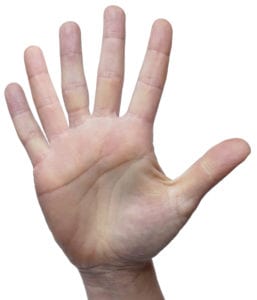 Polydactyly is a deformity where the hands or feet grow extra digits. These are often detected in-utero. It’s best to remove the extra digit when the child is still an infant, old enough to tolerate anesthesia and surgery, yet young enough to not miss any developmental milestones.
Polydactyly is a deformity where the hands or feet grow extra digits. These are often detected in-utero. It’s best to remove the extra digit when the child is still an infant, old enough to tolerate anesthesia and surgery, yet young enough to not miss any developmental milestones.
Dr. Smith performs polydactyly surgery for patients across New York and New Jersey.
Schedule a Consultation Today!
What is polydactyly?
Having an extra finger or toe is called polydactyly. In most cases, the extra digit is smaller than the other digits. It may be a small, raised bump, or a complete working finger or toe. Sometimes the extra digit is only skin, known as a nubbin. In other cases, the digit has all the normal tissues (bone, muscles, blood vessels, and nerves), and it connects to the hand or foot deep inside.
How is an extra finger removed?
 These extra digits need to be removed in early childhood. The goal of these procedures with Dr. Smith is to give the child a hand or foot that works well and looks normal. The method used by Dr. Smith varies depending upon the development of the digit, and how it connects to the hand or foot.
These extra digits need to be removed in early childhood. The goal of these procedures with Dr. Smith is to give the child a hand or foot that works well and looks normal. The method used by Dr. Smith varies depending upon the development of the digit, and how it connects to the hand or foot.
Vascular clip
If the digit is poorly formed and contains no bone, Dr. Smith may be able to simply attach a vascular clip at the base of the digit during a visit to our offices. This vascular clip stops the blood flow to the digit so it will fall off, like the stump of the belly button does soon after birth. After he attaches the clip, he places a bandage over the areas. In a couple weeks, the bandage is removed, and the digit should have fallen off.
Polydactyly Surgery
If surgery is required, the method will be dictated by the degree of development of the extra digit. If the stalk is small, Dr. Smith may perform the surgery in our offices. If it is larger, a hospital setting will be required. Surgery is typically done when the child is 1 year old.
Removing an extra little finger is usually not complicated, especially if the finger is only attached by a narrow stalk.
Removing an extra thumb can be complex. The thumb is of primary importance in hand function, and thumb polydactyly can negatively impact thumb position (angle), shape, and function. Often, Dr. Smith not only needs to remove the extra thumb, but also is required to remodel the existing thumb, working with the soft tissues, tendons, joints, and ligaments.
Removing an extra central finger is usually a complex procedure involving significant reconstruction of the entire hand. These sometimes require more than a single surgery.
Schedule a Consultation Today!
Does polydactyly surgery require anesthesia?
Unless the digit is simply a numb and can be tied off with a vascular clip, surgery will be necessary to remove it, and anesthesia will be necessary. That’s why the child must be old enough to tolerate anesthesia before he or she can have this procedure.
What happens if you don’t have an extra finger removed?
There isn’t any reason not to have surgery to correct polydactyly on your child’s hand or foot. On the feet, these extra digits will make it virtually impossible to find shoes that fit properly. On the hands, the extra digit sets up the child for a lifetime of teasing and unwanted attention paid to the atypical hand. These are not difficult surgeries, and the patient usually regains full function of the hand or foot. There may be some physical and occupational therapy involved, but the prognosis is usually favorable.
Can the extra finger grow back?
No. Once the extra digit is removed it will not return.
Will the child need x-rays prior to surgery?
 If the digit seems more developed, the child may need an x-ray to see if there are bones in the extra digit and to see how the digit connects to the rest of the hand or foot.
If the digit seems more developed, the child may need an x-ray to see if there are bones in the extra digit and to see how the digit connects to the rest of the hand or foot.
What is recovery like after polydactyly surgery?
Recovery depends on how developed the extra digit was. If the surgery to remove the extra digit was fairly complex, it can also involve the child’s bones, ligaments, and tendons. In these instances, the child will need to wear a cast for a few weeks. It’s likely that occupational or physical therapy, or both, would be recommended by Dr. Smith so that the child will have reduced scarring, stiffness, swelling, and improved function moving forward.
If the reconstructive surgery is more involved, Dr. Smith may need to perform more than a single procedure to achieve full function and for the best appearance.
Schedule a Consultation Today!
If you want to learn how more about the removal of the extra digit, Contact on of our offices near New Brunswick, NJ, Staten Island, NY, and Brooklyn, NY. You can also call us at (718) 608-1111, or check out our Cosmetic Surgery Blog.
